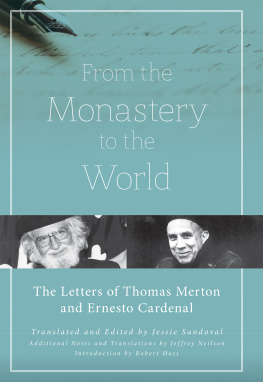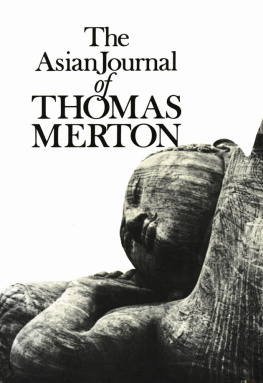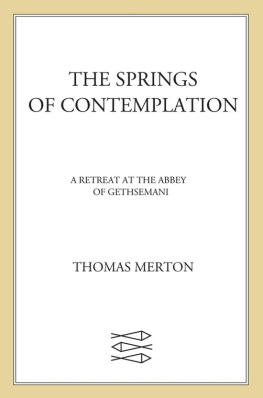Copyright 1953 by the Abbey of Our Lady of Gethsemani
Copyright renewed 1981 by The Trustees of the Merton Legacy Trust
All rights reserved. No part of this publication may be reproduced or transmitted in any form or by any means, electronic or mechanical, including photocopy, recording, or any information storage and retrieval system, without permission in writing from the publisher.
For information about permission to reproduce selections from this book, write to or to Permissions, Houghton Mifflin Harcourt Publishing Company, 3 Park Avenue, 19th Floor, New York, New York 10016.
www.hmhco.com
Ex Parte Ordinis
Nihil Obstat: Fr. M. Maurice Malloy, O.C.S.O.
Fr. M. Paul Bourne, O.C.S.O.
Fr. M. Albert Derzelles, O.C.S.O.
Imprimi Potest: Fr. M. Gabriel Sortais, O.C.S.O, Abbot General
Nihil Obstat: Thomas W. Smiddy, S.T.L., Censor librorum
Imprimatur: T HOMAS E DMUNDUS M OLLOY, S.T.D.
Archiepiscopus-Episcopus
Brooklyniensis
The Library of Congress has cataloged the print edition as follows:
Merton, Thomas, 19151968.
The sign of Jonas.
(A Harvest book)
1. Merton, Thomas, 19151968. 2. Trappists in the United StatesBiography. I. Title.
BX 4705. M 542 A 32 1979 271'.125'024 79-10283
ISBN 0-15-602800-X
e ISBN 978-0-547-54496-0
v4.0817
Beatissimae Virgini Mariae Dolorosae
The sign Jesus promised to the generation that did not understand Him was the sign of Jonas the prophetthat is, the sign of His own resurrection. The life of every monk, of every priest, of every Christian is signed with the sign of Jonas, because we all live by the power of Christs resurrection. But I feel that my own life is especially sealed with this great sign, which baptism and monastic profession and priestly ordination have burned into the roots of my being, because like Jonas himself I find myself traveling toward my destiny in the belly of a paradox.
PROLOGUE
Journey to Nineveh
This book, which is a collection of personal notes and meditations set down during about five years of my life in the monastery of Gethsemani, was not written with any thought that it might be read by persons unfamiliar with the monastic life. Therefore in writing it I never bothered to explain the customary events and regular exercises of a Trappists daily life and never thought it necessary to fill in the background. But some of this Journal may be puzzling unless the reader has at least a sketchy outline of the monastery and of community life in his mind.
Two things are important. First, what the Trappist life itself is and second, the special force acquired by that life under the momentum of what is called a period of fervor. Much of the meaning of this Journal lies in the fact that it has been written at a rare and unusual moment in the history of one particular monastery. The book is not about the monastery, nor about its surprising present condition. But it reflects something of the reactions of an individual caught in the throes of that condition.
The average Trappist monastery is a quiet, out-of-the-way placeusually somewhere in Franceoccupied by a community of seventy or eighty men who lead a silent energetic life consecrated entirely to God. It is a life of prayer and of penance, of liturgy, study, and manual labor. The monks are supposed to exercise no exterior ministryno preaching, teaching, or the rest. The only teaching done by the monks is confined to classes of theology and philosophy within the monastery itselfclasses attended by the young monks, or scholastics, preparing for the priesthood.
The life is physically hard, but the compensation for this hardship is interior peace. In any case, one soon becomes used to the hardships and finds that they are not so hard after all. Seven hours of sleep are normally enough. The monks diet is extremely plain, but is ordinarily enough to keep a man healthy for long years, and monks traditionally die of old age. One soon gets used to sleeping on straw and boards. Most monks would find it difficult to sleep on a soft mattress, after their simple pallets.
The life is usually quiet. There is no conversation. The monks talk to their superiors or spiritual directors when necessary. In the average monastery, Trappist silence is an all-pervading thing that seeps into the very stones of the place and saturates the men who live there.
Farm labor is the monks support, and the ordinary thing is for all the monks to work outdoors for five or six hours a day. When they are not working, or praying in choir, the monks devote their time to reading, meditation, contemplative prayer. The whole day is supposed eventually to become a prolonged prayer in which the monk remains united with God through all his occupations. This is the real purpose of the monastic life: a more or less habitual state of simple prayer and union with God which varies in intensity at different times of the day, which finds a particular and proper rhythm in the life of each individual, and which brings the soul of the monk at all times under the direct and intimate influence of Gods action.
But now, let us suppose that within four or five years, several hundred men decide that they want lives of silence, prayer, labor, penance, and constant union with God in solitude. And suppose they all decide to enter the same monastery. Although they do not all enter exactly at the same moment, they come in great numbers, continually, and the monastery of seventy grows to a hundred and seventy and then to two hundred and seventy.
Thus two hundred and seventy lovers of silence and solitude are all packed into a building that was built for seventy. Priests are needed to give them their formation and spiritual direction. It takes at least eight years to train a man for the priesthood, unless he has been in a seminary before coming to the monastery. Meanwhile, to relieve the pressure, four foundationsthat is, new monasteriesare made. But these new monasteries are staffed with the most capable of the priests in the Mother Community. Consequently there are very few priests left at the Mother House to shoulder the burden of governing and caring for a community of two hundred and seventy. Hence they have a lot of extra work to do!
Meanwhile, new buildings have to be put up, and the farm has to be completely reorganized and expanded, so that all these new arrivals may be fed and housed. Since all this work has to be done in a hurry, many machines are needed. When you have a great crowd of postulants, much work, new buildings, and a small mechanized army of builders all working at high pressure, the silence is not always absolutely perfect.
The young monk who makes his vows at Gethsemani in this unusual moment of crisis and transition is therefore exposing himself to something far more than the ordinary vicissitudes of a Trappist monastery. He is walking into a furnace of ambivalence which nobody in the monastery can fully account for and which is designed, I think, to serve as a sign and a portent to modern America.
The phenomenon which has suddenly happened at Gethsemani came about without anybodys foreseeing it and without anyone making any logical attempt to control it. It was apparently beyond foreseeing and beyond control, and there is no one in the monastery who does not sometimes find himself fearful when he considers its possible issue.
The notes set down in this Journal must be seen in this context of ambivalence, of questioning, of supreme spiritual risk. I do not know and do not attempt to guess what supernatural issues may hang upon the loyal and successful living out of our special problem in this Gethsemani. But I know that the peculiar situation here has given each one of the monks his own opportunity to share in the mysterious and secret testing of spirit which was Christs own Gethsemani. Our monastery was not named in vain for the Garden of the Agony, but I promise not to be dramatic about that side of our existence. I have a peculiar horror of one sin: the exaggeration of our trials and of our crosses.
Next page
















